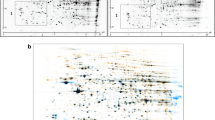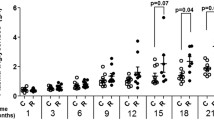Abstract
The chlorinated propanols 2- and 3-monochloropropanediol (MCPD), and their fatty acid esters have gained public attention due to their frequent occurrence as heat-induced food contaminants. Toxic properties of 3-MCPD in kidney and testis have extensively been characterized. Other 3-MCPD target organs include heart and liver, while 2-MCPD toxicity has been observed in striated muscle, heart, kidney, and liver. Inhibition of glycolysis appears to be important in 3-MCPD toxicity, whereas mechanisms of 2-MCPD toxicity are still unknown. It is thus not clear whether toxicity by the two isomeric compounds is dependent on similar or dissimilar modes of action. A 28-day oral feeding study in rats was conducted using daily non-toxic doses of 2-MCPD or 3-MCPD [10 mg/kg body weight], or an equimolar (53 mg/kg body weight) or a lower (13.3 mg/kg body weight) dose of 2-MCPD dipalmitate. Comprehensive comparative proteomic analyses of substance-induced alterations in the common target organ heart revealed striking similarities between effects induced by 2-MCPD and its dipalmitate ester, whereas the degree of effect overlap between 2-MCPD and 3-MCPD was much less. The present data demonstrate that even if exerting effects in the same organ and targeting similar metabolic networks, profound differences between molecular effects of 2-MCPD and 3-MCPD exist thus warranting the necessity of separate risk assessment for the two substances. This study for the first time provides molecular insight into molecular details of 2-MCPD toxicity. Furthermore, for the first time, molecular data on 3-MCPD toxicity in the heart are presented.





Similar content being viewed by others
References
Abraham K, Appel KE, Berger-Preiss E et al (2013) Relative oral bioavailability of 3-MCPD from 3-MCPD fatty acid esters in rats. Arch Toxicol 87(4):649–659
Andres S, Appel KE, Lampen A (2013) Toxicology, occurrence and risk characterisation of the chloropropanols in food: 2-monochloro-1,3-propanediol, 1,3-dichloro-2-propanol and 2,3-dichloro-1-propanol. Food Chem Toxicol 58:467–478
Bakhiya N, Abraham K, Gurtler R, Appel KE, Lampen A (2011) Toxicological assessment of 3-chloropropane-1,2-diol and glycidol fatty acid esters in food. Mol Nutr Food Res 55(4):509–521
Barocelli E, Corradi A, Mutti A, Petronini PG (2011) Scientific report submitted to EFSA: “Comparison between 3-MCPD and its palmitic esters in a 90-day toxicological study”. https://www.efsa.europa.eu/de/supporting/pub/187e. Accessed 05 Dec 2016
Braeuning A, Sawada S, Oberemm A, Lampen A (2015) Analysis of 3-MCPD- and 3-MCPD dipalmitate-induced proteomic changes in rat liver. Food Chem Toxicol 86:374–384
Buhrke T, Weisshaar R, Lampen A (2011) Absorption and metabolism of the food contaminant 3-chloro-1,2-propanediol (3-MCPD) and its fatty acid esters by human intestinal Caco-2 cells. Arch Toxicol 85(10):1201–1208
Buhrke T, Frenzel F, Kuhlmann J, Lampen A (2015) 2-Chloro-1,3-propanediol (2-MCPD) and its fatty acid esters: cytotoxicity, metabolism, and transport by human intestinal Caco-2 cells. Arch Toxicol 89(12):2243–2251
Corley RA, Meek ME, Carney EW (2005) Mode of action: oxalate crystal-induced renal tubule degeneration and glycolic acid-induced dysmorphogenesis–renal and developmental effects of ethylene glycol. Crit Rev Toxicol 35(8–9):691–702
Crews C, Hough P, Brereton P, Harvey D, Macarthur R, Matthews W (2002) Survey of 3-monochloropropane-1,2-diol (3-MCPD) in selected food groups, 1999–2000. Food Addit Contamin 19(1):22–27
Gorg A, Obermaier C, Boguth G et al (2000) The current state of two-dimensional electrophoresis with immobilized pH gradients. Electrophoresis 21(6):1037–1053
IARC (2012) 3-Monochloro-1,2-propanediol IARC Monographs on the evaluation of carcinogenic risks to humans, vol 101, IARC Press, Lyon, p 349–374
Jedrkiewicz R, Kupska M, Glowacz A, Gromadzka J, Namiesnik J (2016) 3-MCPD: a worldwide problem of food chemistry. Crit Rev Food Sci Nutr 56(14):2268–2277
Jones AR, Fakhouri G (1979) Epoxides as obligatory intermediates in the metabolism of alpha-halohydrins. Xenobiotica 9(10):595–599
Jones AR, Porter LM (1995) Inhibition of glycolysis in boar spermatozoa by alpha-chlorohydrin phosphate appears to be mediated by phosphatase activity. Reprod Fertil Dev 7(5):1089–1094
Kaze N, Watanabe Y, Sato H et al (2016) Estimation of the intestinal absorption and metabolism behaviors of 2- and 3-monochloropropanediol esters. Lipids 51(8):913–922
Kuhlmann J (2011) Determination of bound 2,3-epoxy-1-propanol (glycidol) and bound monochloropropanediol (MCPD) in refined oils. Eur J Lipid Sci Technol 113:335–344
Lee BS, Park SJ, Kim YB et al (2015) A 28-day oral gavage toxicity study of 3-monochloropropane-1,2-diol (3-MCPD) in CB6F1-non-Tg rasH2 mice. Food Chem Toxicol 86:95–103
Lu J, Wang Z, Ren M et al (2015) A 4-week study of four 3-monochloropropane-1,2-diol diesters on lipid metabolism in C57BL/6 J mice. Environ Toxicol Pharmacol 40(2):453–458
Lynch BS, Bryant DW, Hook GJ, Nestmann ER, Munro IC (1998) Carcinogenicity of monochloro-1,2-propanediol (a-chlorohydrin, 3-MCPD). Int J Toxicol 17:47–76
Mohri H, Suter DA, Brown-Woodman PD, White IG, Ridley DD (1975) Identification of the biochemical lesion produced by alpha-chlorohydrin in spermatozoa. Nature 255(5503):75–77
Oberemm A, Ahr HJ, Bannasch P et al (2009) Toxicogenomic analysis of N-nitrosomorpholine induced changes in rat liver: comparison of genomic and proteomic responses and anchoring to histopathological parameters. Toxicol Appl Pharmacol 241(2):230–245
Onami S, Cho YM, Toyoda T et al (2015) Orally administered glycidol and its fatty acid esters as well as 3-MCPD fatty acid esters are metabolized to 3-MCPD in the F344 rat. Regul Toxicol Pharmacol 73(3):726–731
Paal K, Meckert C, Taufmann M et al (2006) Improved detection of detoxifying enzymes in rat liver crude extract by optimisation of the standard two-dimensional gel electrophoresis. Naunyn Schmiedeberg’s Arch Pharmacol 372(Supplement 1):123
Rabilloud T (2000) Detecting proteins separated by 2-D gel electrophoresis. Anal Chem 72(1):48A–55A
Sawada S, Oberemm A, Buhrke T et al (2015) Proteomic analysis of 3-MCPD and 3-MCPD dipalmitate toxicity in rat testis. Food Chem Toxicol 83:84–92
Sawada S, Oberemm A, Buhrke T, Merschenz J, Braeuning A, Lampen A (2016) Proteomic analysis of 3-MCPD and 3-MCPD dipalmitate-induced toxicity in rat kidney. Arch Toxicol 90:1437–1448
Scharmach E, Buhrke T, Lichtenstein D, Lampen A (2012) Perfluorooctanoic acid affects the activity of the hepatocyte nuclear factor 4 alpha (HNF4alpha). Toxicol Lett 212(2):106–112
Seefelder W, Varga N, Studer A, Williamson G, Scanlan FP, Stadler RH (2008) Esters of 3-chloro-1,2-propanediol (3-MCPD) in vegetable oils: significance in the formation of 3-MCPD. Food Addit Contamin Part A 25(4):391–400
Skamarauskas J, Carter W, Fowler M et al (2007) The selective neurotoxicity produced by 3-chloropropanediol in the rat is not a result of energy deprivation. Toxicology 232(3):268–276
Steiner SR, Milton E, Philbert MA (2013) A comparative study of protein carbonylation and mitochondrial dysfunction using the neurotoxicants 1,3-dinitrobenzene, 3-nitropropionic acid, and 3-chloropropanediol. Neurotoxicology 37:74–84
Sun J, Bai S, Bai W et al (2013) Toxic mechanisms of 3-monochloropropane-1,2-diol on progesterone production in R2C rat leydig cells. J Agric Food Chem 61(41):9955–9960
Weisshaar R (2011) Fatty acid esters of 3-MCPD: overview of occurrence and exposure estimates. Eur J Lipid Sci Technol 113:304–308
Wenzl T, Lachenmeier DW, Gokmen V (2007) Analysis of heat-induced contaminants (acrylamide, chloropropanols and furan) in carbohydrate-rich food. Anal Bioanal Chem 389(1):119–137
Wilson MA (2011) The role of cysteine oxidation in DJ-1 function and dysfunction. Antioxid Redox Signal 15(1):111–122
Wohrlin F, Fry H, Lahrssen-Wiederholt M, Preiss-Weigert A (2015) Occurrence of fatty acid esters of 3-MCPD, 2-MCPD and glycidol in infant formula. Food Addit Contamin Part A 32(11):1810–1822
Acknowledgements
Technical assistance by Linda Brandenburger, Christine Meckert and Christel Rozycki is greatly acknowledged. This study was supported by the Federal Institute for Risk Assessment [Grant 1322-542].
Author information
Authors and Affiliations
Corresponding author
Electronic supplementary material
Below is the link to the electronic supplementary material.
Rights and permissions
About this article
Cite this article
Schultrich, K., Frenzel, F., Oberemm, A. et al. Comparative proteomic analysis of 2-MCPD- and 3-MCPD-induced heart toxicity in the rat. Arch Toxicol 91, 3145–3155 (2017). https://doi.org/10.1007/s00204-016-1927-0
Received:
Accepted:
Published:
Issue Date:
DOI: https://doi.org/10.1007/s00204-016-1927-0




